Places
Planet, Class-T
Ultragiant. Age ranged from 2-10 billion years. Diameter was 50 to 120 million km. Typically located in the Cold Zone of a planetary system. Surface radiated considerable heat and was tenuous and composed of gaseous hydrogen and hydrogen compounds, atmospheric zones vary in temperature, pressure and composition, and water vapor may be present. No known native life forms.[1]
Class-T Planets:
- None encountered
References
Planet, Class-S
Ultragiant. Age ranged from 2-10 billion years. Diameter was 10 to 50 million km. Typically located in the Cold Zone of a planetary system. Surface radiated considerable heat and was tenuous and composed of gaseous hydrogen and hydrogen compounds, atmospheric zones vary in temperature, pressure and composition, and water vapor may be present. No known native life forms.[1]
Class-S Planets
- None encountered
References
- 1. Star Trek: Star Charts. Book. Pocket Books. October 2002.
Planet, Class-R
Rogue. Age ranged from 2-10 billion years. Diameter is 4000 to 15,000 km. Typically located in interstellar space or cometary halos. Surface may have been temperate due to geothermal venting; atmosphere was primarily volcanic outgassing. May contain non-photosynthetic plants and animal life.[1]
Class-R Planets:
References
Planet, Class-Q
Variable. Age ranged from 2-10 billion years. Diameter was 4000 to 15,000 km. Typically located in the Hot Zone, Ecosphere, or Cold Zone of a planetary system. Surface ranged from molten to water and/or carbon dioxide ice, due to eccentric orbit or variable output of parent star; atmosphere ranged from tenuous to very dense.[1]
Class-Q Planets:
References
Planet, Class-P
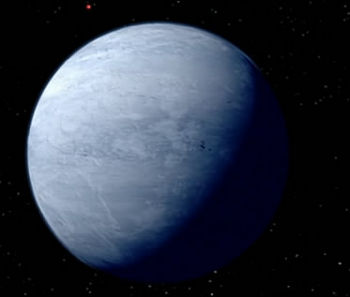
Exo III (TOS-09)
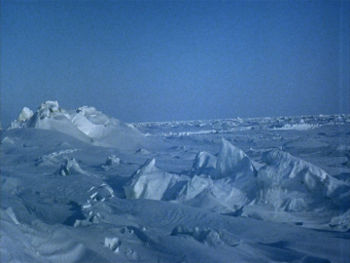
Exo III Surface (TOS-09)
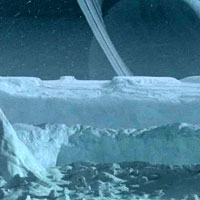
Andoria Surface (ENT-90)
Glaciated. Age ranged from 3-10 billion years. Diameter was 10,000 to 15,000 km. Typically located in the Ecosphere of a planetary system. Water ice covered 80% or more of the surface area, atmosphere consisted of nitrogen, oxygen, and trace elements. May have contained hardy vegetation, animal life, and possibly humanoids.[1]
Class-P Planets:
References
Planet, Class-O
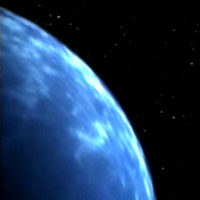
Pacifica (TNG-145)

Class-O Planet (ENT-56)
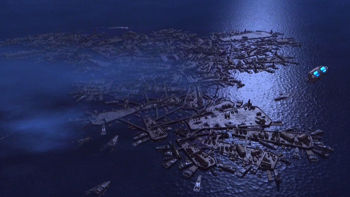
Class-O Planet Surface (ENT-56)
Pelagic. Age ranged from 3-10 billion years. Diameter was 10,000 to 15,000 km. Typically located in the Ecosphere of a planetary system. Liquid water covered 80% or more of the surface area, atmosphere consisted of nitrogen, oxygen, and trace elements. May have contained aquatic vegetation, animal life, and possibly humanoids.[1]
References
- 1. Star Trek: Star Charts. Book. 2002. Pocket Books.
Planet, Class-N
Reducing. Age ranged from 3-10 billion years. Diameter was 10,000 to 15,000 km. Typically located in the Ecosphere of a planetary system. High surface temperatures due to greenhouse effect; water existed only as vapor. Atmosphere was extremely dense, consisting mostly of carbon dioxide and sulfides. No known native life forms.[1]
Class-N Planets:
References
Planet, Class-M

Earth (ENT-78)
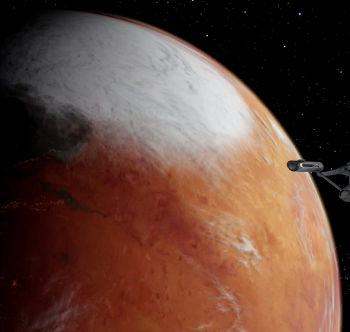
Vulcan (TOS-34)
Terrestrial. Age ranged from 3-10 billion years. Diameter was 10,000 to 15,000 km. Typically located in the Ecosphere of a planetary system. Surface water was abundant; if water or ice covered more than 80% of the surface, the planet was considered Class O or Class P. Atmosphere was primarily primarily nitrogen, oxygen, and trace elements. Contained extensive vegitation and animal life.[8] Capable of supporting carbon-based, humanoid life.[1]
The designation apparently stemmed from the Vulcan word “Minshara,” which was used to designate planets capable of supporting life.[7] Class-M planets could vary widely in color, cloud cover, and overall appearance. Most Class-M planets were characterized by a relatively thin, tectonically active crust floating on a molten rock mantle, which in turn surrounded a liquid metal outer core and a solid inner core composed of metal crystals.
› Continue reading
Planet, Class-L
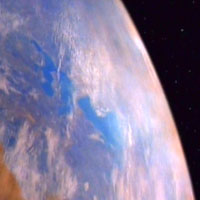
Indri VIII (TNG-246)
Marginal. Age ranged from 4-10 billion years. Diameter was 10,000 to 15,000 km. Typically located in the Ecosphere of a planetary system. Surface was rocky and barren, with little surface water; atmosphere was oxygen/argon, with a high concentration of carbon dioxide. Suitable for humanoid colonization. Typically had limited plant life.[1]
Class-L Planets
References
- 1. “The Chase.” Star Trek: The Next Generation, Episode 246. Television. 26 April 1993.
- 2. Star Trek: Star Charts. Book. Pocket Books. October 2002.
Planet, Class-K
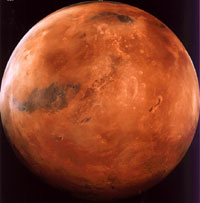
Mars (STSC)

Mudd (TOS-41)
Adaptable. Age ranged from 4-10 billion years. Diameter was 5000 to 10,000 km. Typically located in the Ecosphere of a planetary system. Surface was barren, with little or no surface water, atmosphere was thin and mostly carbon dioxide. Adaptable for humanoid colonization through the use of pressure domes and terraforming. May contain primitive single-celled organisms.[1]
Class-K Planets:
References
Categories
- Animated Series (60)
- Articles (28)
- Books (447)
- Cast & Crew (79)
- Comics (22)
- DS9 (328)
- Early Voyages (125)
- Education (5)
- Enterprise (373)
- Excelsior (36)
- Food (19)
- Games (223)
- Klingon (70)
- Library (1,543)
- Logs (593)
- Lost Era (55)
- Medicine (18)
- Merrimac (1)
- Mirror (35)
- Miscellaneous (13)
- New Frontier (54)
- Next Generation (635)
- Original Series (681)
- Personnel (436)
- Places (369)
- Politics (12)
- Recreation (10)
- SCE (41)
- Science (1)
- Shatnerverse (9)
- Ships (455)
- Site Updates (98)
- Starfleet Academy (86)
- Stargazer (42)
- STO (61)
- Technology (45)
- Titan (59)
- To Boldly Go (1)
- TV/Film (214)
- Uncategorized (4)
- Vanguard (76)
- Voyager (236)
- Weapons (27)
- Xenology (54)